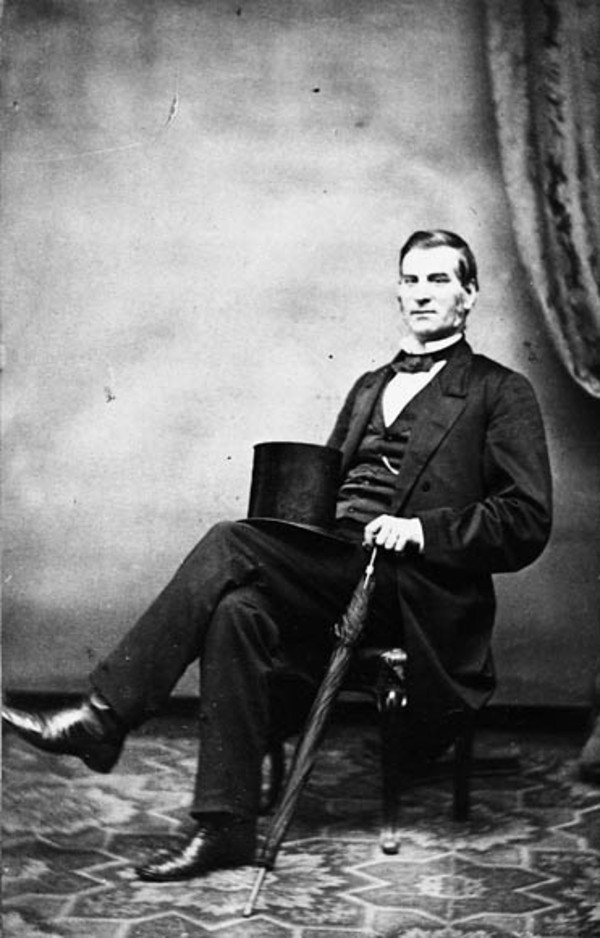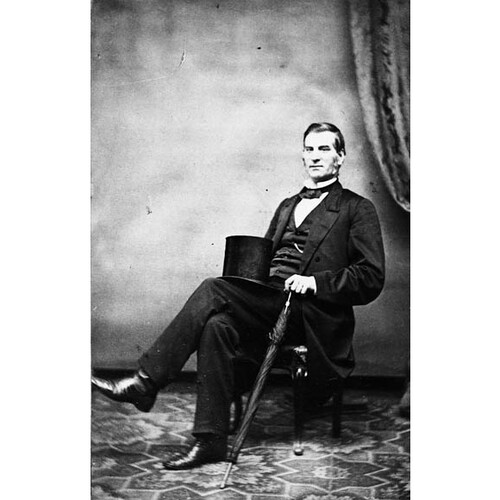STEEVES, WILLIAM HENRY, merchant, lumberman, and politician; b. 20 May 1814 at Hillsborough, Westmorland County (Albert County), N.B., son of Joseph Steeves and Martha Cross, and great-grandson of Heinrich Stief (Henry Steeves) who came to New Brunswick from Germany in 1765; d. 9 Dec. 1873 at Saint John, N.B.
William Henry Steeves attended public school at Hillsborough. His teacher was Duncan Shaw, a native of Scotland, a graduate of the University of Edinburgh, and a prominent early educator in the colony. Steeves always gave the impression that he had much more education than was usually acquired in New Brunswick by persons attending only public school and he attributed this to the teaching of Mr Shaw. He married Mary Steeves, another great-grandchild of Heinrich Stief; they had six children, two sons and four daughters.
Steeves began his business career with a small store and then became a partner of James Abel Steeves and Gilbert Martin Steeves in the firm of Steeves Brothers, a mercantile and lumber export business with headquarters at Hillsborough. He later moved to Saint John where he continued in the lumber export business and became a leader in the financial and commercial activities of the city. His brother Gilbert moved to Liverpool, England, and established a branch office to handle the company’s overseas interests.
When Albert County was created in 1846, Steeves was elected as one of its first two representatives in the House of Assembly. He was reelected at the general election of 1850, but only sat for one session. Steeves favoured reform of the government and in 1851 voted for an unsuccessful bill which would have required that all members of the Legislative Council be elected; he also voted against paying council members.
Steeves was appointed to the Legislative Council in December 1851. In 1852 he was apparently offered the position of surveyor general by the lieutenant governor, Sir Edmund Head*, who wished to appoint to the government someone from Saint John since that city was the headquarters of opposition to his advisers led by Edward Barron Chandler. Steeves declined the office, which finally went to Robert Duncan Wilmot*, also a Saint John critic of the government. In 1854 the compact government was defeated and Charles Fisher headed a new liberal, reform, or “smasher” administration. The governor, John Henry Thomas Manners-Sutton, described this government as “formed on the principle that the direction of public affairs had been too long in the hands of men of property and liberal education.” Steeves was again offered the position of surveyor general and this time he accepted. His appointment was opposed by many members of the assembly, who felt that the surveyor general should be selected from among the elected representatives. Accepting this criticism, Steeves resigned on 4 Dec. 1854.
In March 1855 he was appointed the first chairman of the newly created Department of Public Works – a position he held until 30 May 1856. He was then out of office for a short time when the government led by Fisher and Samuel Leonard Tilley* was defeated over the unpopular prohibition act. The “smasher” government was returned to power in 1857, Steeves regained his post as chief commissioner of the Department of Public Works, and kept it until 1861. He was the only member of the Legislative Council ever to hold this office. As minister without portfolio he continued in the Tilley government from 1861 until April 1865, when Tilley and his supporters were defeated over the issue of confederation.
Steeves was an advocate of railway communications and was eager to promote schemes which would benefit Saint John. For this reason he was interested in the Intercolonial Railway and the route it would follow through New Brunswick. He was a member of the delegation sent to Quebec in September 1862 to discuss the proposals of the Duke of Newcastle [Henry Pelham Clinton] for imperial aid in the construction of the Intercolonial.
A supporter of Maritime union and confederation, Steeves was a New Brunswick delegate at the Charlottetown conference in September 1864. He was also a delegate to the Quebec conference in October 1864 when the terms of confederation were discussed. In these meetings he supported Sir Leonard Tilley, but there is no record of his having made any speeches of importance. As a reward for his support of confederation, Steeves was called to the Canadian Senate in July 1867 as one of the original 12 senators for New Brunswick.
In his later years, Steeves became interested in the treatment of the insane. Probably encouraged by his brother, Dr James Thomas Steeves, a prominent Saint John physician who in 1876 succeeded John Waddell as superintendent of the provincial insane asylum at Saint John, he supported reform and improved facilities for this institution. One obituary credits him with part responsibility for legislation providing better treatment for the mentally ill.
Although Steeves’ career was not spectacular he served capably in the government of New Brunswick for many years. He consistently advocated reform and his loyal support of Sir Leonard Tilley assisted in the struggle to bring New Brunswick into confederation.
N.B. Museum, Hazen papers, draft of a protest regarding the Board of Works under W. H. Steeves; Steeves family, miscellaneous genealogical notes; Tilley family papers, W. H. Steeves to S. L. Tilley, 13 Jan. 1863; Webster coll., W. H. Steeves to A. R. McClelan, 10 Dec. 1852, 2 May 1855. University of New Brunswick, Graves (New Brunswick), mss, Albert County, 32. Daily Telegraph (Saint John, N.B.), 10 Dec. 1873. Morning Freeman (Saint John, N.B.), 11 Dec. 1873. New Brunswick Reporter (Fredericton), 10 Dec. 1873. Fenety, Political notes and observations, 307–38, 405. Can. parl. comp., 1872. E. C. Wright, The Steeves descendants (Wolfville, N.S., [1965]), 667–68. Hannay, History of New Brunswick, II, 170–71, 185, 201, 221, 225. MacNutt, New Brunswick, 353–88. E. C. Wright, Samphire Greens: the story of the Steeves (Kingsport, N.S., [1961]).
Cite This Article
W. A. Spray, “STEEVES, WILLIAM HENRY,” in Dictionary of Canadian Biography, vol. 10, University of Toronto/Université Laval, 2003–, accessed January 18, 2026, https://www.biographi.ca/en/bio/steeves_william_henry_10E.html.
The citation above shows the format for footnotes and endnotes according to the Chicago manual of style (16th edition). Information to be used in other citation formats:
| Permalink: | https://www.biographi.ca/en/bio/steeves_william_henry_10E.html |
| Author of Article: | W. A. Spray |
| Title of Article: | STEEVES, WILLIAM HENRY |
| Publication Name: | Dictionary of Canadian Biography, vol. 10 |
| Publisher: | University of Toronto/Université Laval |
| Year of publication: | 1972 |
| Year of revision: | 1972 |
| Access Date: | January 18, 2026 |




